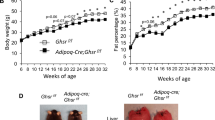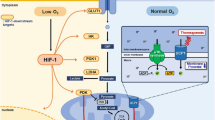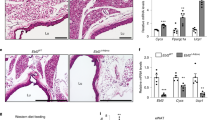Abstract
Objective:
High-fat diets (HFDs) result in increased body weight. However, this is not uniform and determining the factors that make some animals or individual more susceptible to this diet-induced weight gain is a critical research question. The expansion of white adipose tissue (WAT) associated with weight gain requires high rates of angiogenesis to support the expanding tissue mass. We hypothesized that diet-induced obese (DIO) mice have a greater capacity for WAT angiogenesis and remodeling than diet-resistant (DR) mice at a young age, before age or DIO.
Design:
We measured body weight and body composition by nuclear magnetic resonance. We compared the expression of genes related to lipid metabolism, angiogenesis and inflammation by real-time, quantitative PCR and PCR arrays. WAT morphology and distribution of adipocyte size were analyzed. The level of hypoxia and vascular density was assessed by immunohistochemistry in WAT of young mice.
Results:
C57Bl/6 mice were DIO and FVB/N (FVB) mice DR after 8 weeks on a low-fat diet or HFD. However, C57Bl/6 mice had lower body weight, lower adiposity, smaller adipocytes and decreased leptin and lipogenic genes expression in adipose tissue than FVB mice at 9 weeks of age on a chow diet. Despite having smaller adipocytes, the level of hypoxia and the expression of pro-angiogenesis genes were higher in WAT of young C57Bl/6 mice than young FVB mice. In addition, expression of genes related to macrophages and their recruitment, and to proinflammatory cytokines, was significantly higher in WAT of young C57Bl/6 mice than young FVB mice.
Conclusion:
These data suggest that the potential for WAT remodeling in early period of growth is higher in C57Bl/6 mice as compared with FVB mice, and we hypothesize that it may contribute to the increased susceptibility to DIO of C57Bl/6 mice.
This is a preview of subscription content, access via your institution
Access options
Subscribe to this journal
Receive 12 print issues and online access
$259.00 per year
only $21.58 per issue
Buy this article
- Purchase on Springer Link
- Instant access to full article PDF
Prices may be subject to local taxes which are calculated during checkout






Similar content being viewed by others
References
Kozak LP . Brown fat and the myth of diet-induced thermogenesis. Cell Metab 2010; 11: 263–267.
Levin BE . Developmental gene x environment interactions affecting systems regulating energy homeostasis and obesity. Front Neuroendocrinol 2010; 31: 270–283.
Fukumura D, Ushiyama A, Duda DG, Xu L, Tam J, Krishna V et al. Paracrine regulation of angiogenesis and adipocyte differentiation during in vivo adipogenesis. Circ Res 2003; 93: e88–e97.
Rupnick MA, Panigrahy D, Zhang CY, Dallabrida SM, Lowell BB, Langer R et al. Adipose tissue mass can be regulated through the vasculature. Proc Natl Acad Sci USA 2002; 99: 10730–10735.
Crandall DL, Hausman GJ, Kral JG . A review of the microcirculation of adipose tissue: anatomic, metabolic, and angiogenic perspectives. Microcirculation 1997; 4: 211–232.
Kim DH, Woods SC, Seeley RJ . Peptide designed to elicit apoptosis in adipose tissue endothelium reduces food intake and body weight. Diabetes 2010; 59: 907–915.
Kolonin MG, Saha PK, Chan L, Pasqualini R, Arap W . Reversal of obesity by targeted ablation of adipose tissue. Nat Med 2004; 10: 625–632.
Cho CH, Koh YJ, Han J, Sung HK, Jong Lee H, Morisada T et al. Angiogenic role of LYVE-1-positive macrophages in adipose tissue. Circ Res 2007; 100: e47–e57.
Voros G, Maquoi E, Demeulemeester D, Clerx N, Collen D, Lijnen HR . Modulation of angiogenesis during adipose tissue development in murine models of obesity. Endocrinology 2005; 146: 4545–4554.
Silha JV, Krsek M, Sucharda P, Murphy LJ . Angiogenic factors are elevated in overweight and obese individuals. Int J Obes (Lond) 2005; 29: 1308–1314.
Xu H, Barnes GT, Yang Q, Tan G, Yang D, Chou CJ et al. Chronic inflammation in fat plays a crucial role in the development of obesity-related insulin resistance. J Clin Invest 2003; 112: 1821–1830.
Weisberg SP, McCann D, Desai M, Rosenbaum M, Leibel RL, Ferrante AW . Obesity is associated with macrophage accumulation in adipose tissue. J Clin Invest 2003; 112: 1796–1808.
Lumeng CN, Bodzin JL, Saltiel AR . Obesity induces a phenotypic switch in adipose tissue macrophage polarization. J Clin Invest 2007; 117: 175–184.
Kim DH, Sandoval D, Reed JA, Matter EK, Tolod EG, Woods SC et al. The role of GM-CSF in adipose tissue inflammation. Am J Physiol Endocrinol Metab 2008; 295: E1038–E1046.
Hu CC, Qing K, Chen Y . Diet-induced changes in stearoyl-CoA desaturase 1 expression in obesity-prone and -resistant mice. Obes Res 2004; 12: 1264–1270.
Jo J, Gavrilova O, Pack S, Jou W, Mullen S, Sumner AE et al. Hypertrophy and/or Hyperplasia: Dynamics of Adipose Tissue Growth. PLoS Comput Biol 2009; 5: e1000324.
Hajri T, Han XX, Bonen A, Abumrad NA . Defective fatty acid uptake modulates insulin responsiveness and metabolic responses to diet in CD36-null mice. J Clin Invest 2002; 109: 1381–1389.
Coburn CT, Knapp FF, Febbraio M, Beets AL, Silverstein RL, Abumrad NA . Defective uptake and utilization of long chain fatty acids in muscle and adipose tissues of CD36 knockout mice. J Biol Chem 2000; 275: 32523–32529.
Galitzky J, Reverte M, Portillo M, Carpene C, Lafontan M, Berlan M . Coexistence of β1-, β2-, and β3-adrenoceptors in dog fat cells and their differential activation by catecholamines. Am J Physiol Endocrinol Metab 1993; 264: E403–E412.
Van Liefde I, Van Witzenburg A, Vauquelin G . Multiple beta adrenergic receptor subclasses mediate the l-isoproterenol- induced lipolytic response in rat adipocytes. J Pharmacol Exp Ther 1992; 262: 552–558.
Collins S, Daniel KW, Rohlfs EM, Ramkumar V, Taylor IL, Gettys TW . Impaired expression and functional activity of the β3- and β1- adrenergic receptors in adipose tissue of congenitally obese (C57BL/6J ob/ob) mice. Mol Endocrinol 1994; 8: 518–527.
Shi H, Akunuru S, Bierman JC, Hodge KM, Mitchell MC, Foster MT et al. Diet-induced obese mice are leptin insufficient after weight reduction. Obesity (Silver Spring) 2009; 17: 1702–1709.
Cao Y . Angiogenesis modulates adipogenesis and obesity. J Clin Invest 2007; 117: 2362–2368.
Adams RH, Alitalo K . Molecular regulation of angiogenesis and lymphangiogenesis. Nat Rev Mol Cell Biol 2007; 8: 464–478.
Papetti M, Herman IM . Mechanisms of normal and tumor-derived angiogenesis. Am J Physiol Cell Physiol 2002; 282: C947–C970.
Christiaens V, Lijnen HR . Angiogenesis and development of adipose tissue. Mol Cell Endocrinol 2010; 318: 2–9.
Pouysségur J, Dayan F, Mazure NM . Hypoxia signalling in cancer and approaches to enforce tumour regression. Nature 2006; 441: 437–443.
Kuiper EJ, Roestenberg P, Ehlken C, Lambert V, van Treslong-de Groot HB, Lyons KM et al. Angiogenesis is not impaired in connective tissue growth factor (CTGF) knock-out mice. J Histochem Cytochem 2007; 55: 1139–1147.
Inoki I, Shiomi T, Hashimoto G, Enomoto H, Nakamura H, Makino K et al. Connective tissue growth factor binds vascular endothelial growth factor (VEGF) and inhibits VEGF-induced angiogenesis. FASEB J 2002; 16: 219–221.
Shikada Y, Yonemitsu Y, Koga T, Onimaru M, Nakano T, Okano S et al. Platelet-derived growth factor-AA is an essential and autocrine regulator of vascular endothelial growth factor expression in non-small cell lung carcinomas. Cancer Res 2005; 65: 7241–7248.
Yang X, Castilla LH, Xu X, Li C, Gotay J, Weinstein M et al. Angiogenesis defects and mesenchymal apoptosis in mice lacking SMAD5. Development 1999; 126: 1571–1580.
Takeda N, Maemura K, Imai Y, Harada T, Kawanami D, Nojiri T et al. Endothelial PAS domain protein 1 gene promotes angiogenesis through the transactivation of both vascular endothelial growth factor and its receptor, Flt-1. Circ Res 2004; 95: 146–153.
Naiche LA, Papaioannou VE . Loss of Tbx4 blocks hindlimb development and affects vascularization and fusion of the allantois. Development 2003; 130: 2681–2693.
Brown CB, Wenning JM, Lu MM, Epstein DJ, Meyers EN, Epstein JA . Cre-mediated excision of Fgf8 in the Tbx1 expression domain reveals a critical role for Fgf8 in cardiovascular development in the mouse. Dev Biol 2004; 267: 190–202.
Hamano Y, Zeisberg M, Sugimoto H, Lively JC, Maeshima Y, Yang C et al. Physiological levels of tumstatin, a fragment of collagen IV alpha3 chain, are generated by MMP-9 proteolysis and suppress angiogenesis via alphaV beta3 integrin. Cancer Cell 2003; 3: 589–601.
Kzhyshkowska J, Workman G, Cardo-Vila M, Arap W, Pasqualini R, Gratchev A et al. Novel function of alternatively activated macrophages: stabilin-1-mediated clearance of SPARC. J Immunol 2006; 176: 5825–5832.
Tsujii M, Kawano S, Tsuji S, Sawaoka H, Hori M, DuBois RN . Cyclooxygenase regulates angiogenesis induced by colon cancer cells. Cell 1998; 93: 705–716.
Kerber M, Reiss Y, Wickersheim A, Jugold M, Kiessling F, Heil M et al. Flt-1 signaling in macrophages promotes glioma growth in vivo. Cancer Res 2008; 68: 7342–7351.
Shalaby F, Rossant J, Yamaguchi TP, Gertsenstein M, Wu XF, Breitman ML et al. Failure of blood-island formation and vasculogenesis in Flk-1-deficient mice. Nature 1995; 376: 62–66.
Pedram A, Razandi M, Levin ER . Natriuretic peptides suppress vascular endothelial cell growth factor signaling to angiogenesis. Endocrinology 2001; 142: 1578–1586.
Shukunami C, Iyama KI, Inoue H, Hiraki Y . Spatiotemporal pattern of the mouse chondromodulin-I gene expression and its regulatory role in vascular invasion into cartilage during endochondral bone formation. Int J Dev Biol 1999; 43: 39–49.
Yoshioka M, Yuasa S, Matsumura K, Kimura K, Shiomi T, Kimura N et al. Chondromodulin-I maintains cardiac valvular function by preventing angiogenesis. Nat Med 2006; 12: 1151–1159.
Sun K, Kusminski CM, Scherer PE . Adipose tissue remodeling and obesity. J Clin Invest 2011; 121: 2094–2101.
Han J, Lee JE, Jin J, Lim JS, Oh N, Kim K et al. The spatiotemporal development of adipose tissue. Development 2011; 138: 5027–5037.
Kosteli A, Sugaru E, Haemmerle G, Martin JF, Lei J, Zechner R et al. Weight loss and lipolysis promote a dynamic immune response in murine adipose tissue. J Clin Invest 2010; 120: 3466–3479.
Nishimura S, Manabe I, Nagasaki M, Hosoya Y, Yamashita H, Fujita H et al. Adipogenesis in obesity requires close interplay between differentiating adipocytes, stromal cells, and blood vessels. Diabetes 2007; 56: 1517–1526.
Pang C, Gao Z, Yin J, Zhang J, Jia W, Ye J . Macrophage infiltration into adipose tissue may promote angiogenesis for adipose tissue remodeling in obesity. Am J Physiol Endocrinol Metab 2008; 295: E313–E322.
Hosogai N, Fukuhara A, Oshima K, Miyata Y, Tanaka S, Segawa K et al. Adipose tissue hypoxia in obesity and its impact on adipocytokine dysregulation. Diabetes 2007; 56: 901–911.
Bell LN, Cai L, Johnstone BH, Traktuev DO, March KL, Considine RV . A central role for hepatocyte growth factor in adipose tissue angiogenesis. Am J Physiol Endocrinol Metab 2008; 294: E336–E344.
Xin X, Yang S, Ingle G, Zlot C, Rangell L, Kowalski J et al. Hepatocyte growth factor enhances vascular endothelial growth factor-induced angiogenesis in vitro and in vivo. Am J Pathol 2001; 158: 1111–1120.
Suri C, McClain J, Thurston G, McDonald DM, Zhou H, Oldmixon EH et al. Increased vascularization in mice overexpressing angiopoietin-1. Science 1998; 282: 468–471.
Hutley L, Shurety W, Newell F, McGeary R, Pelton N, Grant J et al. Fibroblast growth factor 1: a key regulator of human adipogenesis. Diabetes 2004; 53: 3097–3106.
Acknowledgements
This work was supported by National Institute of Diabetes and Digestive and Kidney Diseases (NIDDK) Grant DK093848 and Basic Science Research Program of the National Research Foundation of Korea (NRF) funded by the Ministry of Education, Science and Technology (2012-0003537).
Author information
Authors and Affiliations
Corresponding author
Ethics declarations
Competing interests
Dr Seeley has served as a paid consultant for Novo Nordisk, Eli Lilly, Angiochem, Novartis and Ethicon Endo-Surgery; as a paid speaker for Novo Nordisk, Pfizer and Ethicon Endo-Surgery; and has received research support from Novo Nordisk, Pfizer, Mannkind, Ablaris and Ethicon Endo-Surgery.
Additional information
Supplementary Information accompanies the paper on International Journal of Obesity website
Supplementary information
Rights and permissions
About this article
Cite this article
Kim, DH., Gutierrez-Aguilar, R., Kim, HJ. et al. Increased adipose tissue hypoxia and capacity for angiogenesis and inflammation in young diet-sensitive C57 mice compared with diet-resistant FVB mice. Int J Obes 37, 853–860 (2013). https://doi.org/10.1038/ijo.2012.141
Received:
Revised:
Accepted:
Published:
Issue Date:
DOI: https://doi.org/10.1038/ijo.2012.141
Keywords
This article is cited by
-
Targeted deletion of keratin 8 in intestinal epithelial cells disrupts tissue integrity and predisposes to tumorigenesis in the colon
Cellular and Molecular Life Sciences (2022)
-
Characterising nitric oxide-mediated metabolic benefits of low-dose ultraviolet radiation in the mouse: a focus on brown adipose tissue
Diabetologia (2020)
-
Lack of cortistatin or somatostatin differentially influences DMBA-induced mammary gland tumorigenesis in mice in an obesity-dependent mode
Breast Cancer Research (2016)
-
Role of MCP-1 on inflammatory processes and metabolic dysfunction following high-fat feedings in the FVB/N strain
International Journal of Obesity (2016)
-
Biological plausibility linking sleep apnoea and metabolic dysfunction
Nature Reviews Endocrinology (2016)



